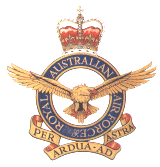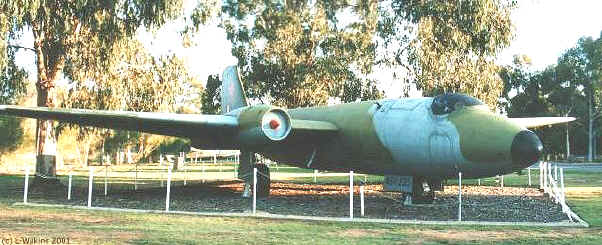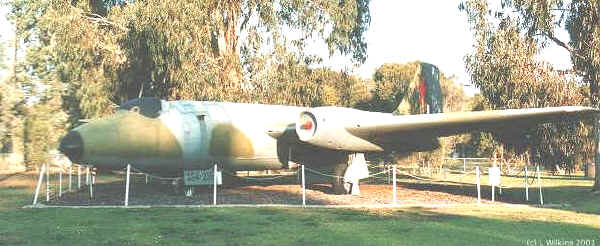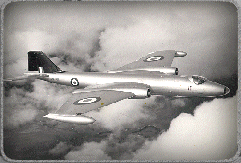 |
2 Squadron RAAF in Vietnam
This Information was supplied by Brendan Lynch,
Secretary of
the RAAF Vietnam Veterans Association
|
DEPLOYMENT
As Australia increased its forces in Vietnam, the decision to deploy an
RAAF bomber squadron to that country was made public on December 23 1966.
From the RAAF's perspective the deployment could not have been more
opportune. The Australian bomber squadrons were equipped with the British
designed, Australian built Canberra twinjet bombers, elderly, but as
events proved, extremely effective.
For Vietnam operations, the RAAF's Canberra's usually carried six 750 lb.
(340 kg) M117 general purpose bombs - four in the bomb bay and one under
each wing tip.
New state of the art F-111s were on order and the timing of the
announcement was such that Australia's future F-111 crews could obtain
valuable combat experience in Vietnam before taking delivery of their new
aircraft in the United States. In the event, this plan was frustrated by
successive delays in the F-111 programme, which went on for several years.
Despite this, the Vietnam deployment went ahead and 2 Squadron was
selected as the unit, which would go. A detachment from 5 Airfield
Construction Squadron (ACS), along with a small 2 Squadron advance party
arrived at Phang Rang Air Base, 250 km north-east of Saigon in February
1967 to prepare for the Squadrons arrival. The Australians were welcomed
to Vietnam (on radio) by "Hanoi Hanna" the communist version of
Tokyo Rose.
"The 5ACS detachment arrived in Saigon from Singapore where we were
ushered straight onto a Caribou to Vung Tau", recalled Sgt. Ron
Campbell. "At Vung Tau we were given a quick meal, issued with
weapons, loaded back onto the Caribou and flown to Phang Rang. You can
imagine the look on the faces of the Americans who were waiting with movie
cameras rolling to welcome the Aussies in their slouch hats, only to be
greeted by a group of people, dressed in new suits (purchased in
Singapore) with rifles over their shoulders!"
The airfield construction men, in cooperation with American troops, worked
long hours to construct 2 Squadron's living quarters, messes, dining hall,
headquarters and maintenance hangar.
By March 1967 the USAF had spent nearly a year building a giant air base
at Phang Rang. The strip was complete; the aircraft revetments in place
and sorties were being flown daily. The rest was industrial organized
mayhem with roads, buildings, water and powerlines being constructed all
over the huge area.
Canberra's arrive in Vietnam
Led by Wng. Cdr. Rolf Aronson, 2 Squadron's 8 Canberra's took off from
Butterworth, Malaysia on April 16 1967 and after a two hour flight touched
down at Phang Rang Air base, South Vietnam. And placed under control of
the USAF 7th Air force and became part of the 35 Tactical Fighter Wing
(TFW).
On April 23, all Canberra's began tactical operations. Wng Cdr. Vin Hill,
DFC, AFC (a combat experienced pilot of the Korean War) and his navigator
were the first to take off.
Low Level
After the 27th, the Squadron operated almost exclusively by night. 8
missions per night, 7 days a week.
After 3 months Wng Cdr. Aronson pressed his American commanders into
allowing 2 Squadron to undertake some daylight visual bombing. But the
American Commander was dubious.
Experimental low level daylight missions proved so successful that 2
Squadron was allowed to fly two and later four of it's missions by day.
The Americans still had reservations - after all the Australians would be
the only ones in Vietnam using the level bombing technique from low level
- a form of attack disliked by the Americans.
A good Record
In October General William C. Westmoreland carried out an inspection of
the base. About 2 Squadron he stated " The RAAF has an elite Canberra
squadron, which has impressed me very much. Its discipline is superb and
there is obviously a very high esprit de corps within the squadron".
On November Wng Cdr. Aronson returned to Australia on the expiration of
his tour of duty. Wng Cdr. David Evans replaced him.
The Australians were deployed to bomb around the besieged Americans at Khe
Sanh. One pilot even recorded an 'accidental" 260 km incursion into
North Vietnam. Flg Off McGregor recalled the start to another mission in 1
Corps right on the DMZ. On rendezvous with a madly weaving FAC he was
given the following ground fire report. "Heavy small arms and LMG
fire to 1000 ft, HMG and Quad 20mm cannon fire to 2500ft, AAA and possible
SAM activity at higher altitude". Busy scene. Flg Off McGregor and
Flg Off Jim Aiken were bombing from only 800 ft, the crew achieved
excellent results, but received bomb shrapnel in the tail-plane of their
aircraft. On return a visiting Air Vice Marshall and their CO were waiting
for them, not overly impressed with the damage. But on being given the
mission details all was "forgiven'
In 1969, Colonel Gailer, the 35th TFW's commander found to his shock that
while only flying about five percent of the 35th TFW's missions, the
Australian squadron was obtaining no less than 16% of the Wings assessed
bomb damage.
Rocket and mortar attacks against Phang Rang continued. One attack began
just as everyone lined up at the mess for lunch. Sgt. Carl Noonan was late
and had just opened the mess door when a mortar round impacted out side.
He was blown through the door, along the floor and into the servery
counter. Quite nonchalantly he stood up and said to the startled cooks,
"I'll have the usual, thanks…!"
Heavy Workload
On April 25, 2 Squadron's 40,000th bomb was dropped while on November 28,
Plt. Off. J Kennedy and Plt. Off. A Curr dropped the 50,000th.Flt. Lt. G
Cramer, a veteran Navigator with many years service in Canberra's, created
a RAAF record by completing 3000 flying hours in Canberras. This was
equivalent to 375 working days, each of 8 hours.
Cramer flew the 3000th hour on his 275th combat mission in South Vietnam.
He returned to Australia after completing 285 missions and was later
awarded the Distinguished Flying Cross. In October 1969 the very last
Martin B-57 (the American built and modified version of the Canberra -
which like other USAF aircraft utilised dive bombing as its form of
attack) squadron departed for the US leaving 2 Squadron as the only
Canberra type unit operating in South East Asia.
Recalling one mission Plt. Off. J Kennedy and Flt. Lt. N Duus commented;
"On reaching the target area, a bunker system in V Corps. The crew
found the cloud base was down to 1000 ft. We were forbidden to bomb below
1000 ft., but 2 Squadron had a reputation for not bring any bombs home.
(Canberra's could land with a full load of bombs. The Americans would not
do this) As a result we decided to bomb from 800ft. " We dropped the
bomb and through the Perspex window I watched it fall. I saw it explode,
then almost immediately the window disintegrated. We thought we'd been hit
by ground fire." "By now we were quite angry with the VC and
advised the FAC that we wanted to drop the rest of the bombs on the
target. This was done and we headed for home".
"On the way back I inspected the damage in the bomb site area. I had
not been wearing flying gloves and received small cuts on my hands. I then
glanced up and around for the first time and saw a large piece of shrapnel
(from our own bomb) which had penetrated through the nose cone and was now
protruding through the upper skin of the aircraft."
"After landing at Phang Rang the realization that I had almost been
killed hit home- hard. So in hindsight the moral of the story is 'if one
is going to drop bombs, one must reach safety height'."
Tragedy struck 2 Squadron on November 3 1970 when Canberra A84-231 failed
to return from on of the squadron's infrequent Combat Sky spot missions.
The aircraft crewed by Flg. Off. M Herbert and Plt. Off. R Carver had
bombed a target in poor weather conditions north of Da Nang when it
disappeared off the Sky spot radar controller's screen. All 2 Squadron
missions scheduled for the next day was cancelled as the remaining
Canberra's joined USAF in a fruitless search for the aircraft and crew. No
trace of the aviators was ever found and no adequate explanation is
available, although many in the Squadron suspected a North Vietnamese SA-2
surface to air missile was responsible. A replacement crew and aircraft
was sent from Australia, as was a new Commander Wng Cdr John Downing. In
January 1971 a Canberra crewed by Flg. Off. Copley and Flt. Lt A Pinches
supported ARVN troops and their Australian Advisor. They were in Heavy
contact with the enemy. The crew destroyed the mortar position; it's crew
and the ammo supply.
Weeks later the Australian Advisor called in to Phang Rang to personally
thank the RAAF fliers for their assistance. And told them how he and his
fellow advisors had purposely misled the FAC's so that the ordinance from
the bombers fell much closer to their own positions than was allowed by
standard operating procedures. This surprising information reinforced to
the Australian crews the need for accurate bombing.
On February 9 1971 Wng. Cdr. Downing and Sqdn Ldr B Johnson in Canberra
A84-234 were to provide immediate close support to allied troops in
contact with the enemy. The troops were in ambush positions so their location could not be marked
by the FAC's. The Canberra made 5 runs over the target in the face of
heavy ground fire. Of the strike the American FAC later recorded:
Their aggressive and accurate deliveries were directly responsible for the
saving of many lives. The first bomb they dropped obliterated five enemy
hootches; successive bombs accounted for a secondary explosion, an enemy
radio station, yards and yards of trenches, bunkers and with no doubt in
my mind significant numbers of enemy soldiers killed.
" Their responses to messages passed from the ground praising their
accuracy and advising them of the intense fire they were taking on each
pass were so calm and professional I was thoroughly dismayed." On the
Australians last run, the Canberra was hit by a massive hunk of shrapnel
which tore through the nose section, narrowly missing the crew and
partially severing the elevator cables before embedding itself in the IFF
panel.
As all their bombs had been expended the Australians calmly wished those
in the FAC's aircraft "a good day" and departed for Phang Rang
where a safe landing was made. For their part in the action Downing and Johnson were awarded American
Distinguished Flying Crosses. Strangely, the two Australian were not
notified of the awards and neither received the medal or the citation to
accompany it.
A Notable finale
Flg. Off. S Fenton and Plt. Off. Murphy in Canberra A84-234 were tasked to
support a US Army Infantry company in heavy contact with a North
Vietnamese force near the Demilitarised Zone. On arrival in the area the
Canberra crew found that the soldiers of both sides were dangerously close
to one another. The FAC directing the strike was gravely concerned that
the friendly troops as well as the enemy would die in the bombing. If,
however, the Canberra was not cleared to attack the friendly troops would
quickly be overrun and wiped out. Reluctantly, the FAC authorised the
attack to begin.
Due to the close proximity to the US troops, the North Vietnamese thought
they would be immune from air attack but on realizing their error they
directed a considerable volume of fire onto the approaching Canberra. As
extreme accuracy was required, the cool Australian Pilot held the Canberra
on a straight and level course through the enemy's gunfire and his equally
calm and efficient navigator released one bomb, achieving excellent
results according to the excited reports from the friendly ground troops.
The North Vietnamese were not so happy with the success of the Canberra's
bombing and directed even more fire at the aircraft.
Another five runs were made over the target with one bomb being released
each time. The North Vietnamese force suffered severely and fled the
battlefield in disorder leaving 80 bodies behind.
Departure
June 4, 1971 was set as the Squadron's day of departure from Vietnam. On
June 1 flying ceased to allow the men to complete packing and movement
arrangements. All eight Canberra's departed Phang Rang on the 4th as
planned and arrived in Darwin a few hours later. The ground staff followed
later in transport aircraft. During it's operational service, 2 Squadron
was credited with the destruction of 7000 BUILDINGS, 10,000 BUNKERS, 1000
SAMPANS, 36 BRIDGES AND AN UNKNOWN NUMBER OF ENEMY TROOPS. The Squadron as
a whole was awarded a Vietnamese cross of Gallantry and a United States
Air Forces Outstanding Unit Commendation for it's service in Vietnam -
high honours indeed. There can be no doubt that 2 squadron was the most
effective tactical fighter/bomber Squadron to operate in South Vietnam.
|



 Although the piston engined Avro Lincoln heavy bomber had only entered
RAAF service in 1946, by late 1948 it was already obvious this aircraft
would become quickly obsolete. Investigations into a more modern
replacement were therefore begun, resulting in the order of 48 English
Electric Canberra jet bombers in 1950.
Although the piston engined Avro Lincoln heavy bomber had only entered
RAAF service in 1946, by late 1948 it was already obvious this aircraft
would become quickly obsolete. Investigations into a more modern
replacement were therefore begun, resulting in the order of 48 English
Electric Canberra jet bombers in 1950.

